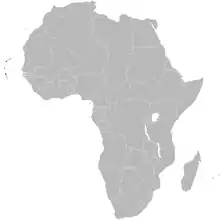Cape Verde warbler
The Cape Verde warbler (Acrocephalus brevipennis) is an Old World warbler in the genus Acrocephalus. It is also known as the Cape Verde cane warbler or Cape Verde swamp warbler, and in Creole as tchota-de-cana or chincherote[2] (also tchintchirote).[3] It breeds on Santiago, Fogo, and São Nicolau in the Cape Verde Islands.[4][5] It previously bred on Brava. This species is found in well-vegetated valleys, avoiding drier areas. It nests in reedbeds, two to three eggs being laid in a suspended nest.[6]
| Cape Verde warbler | |
|---|---|
 | |
| The Cape Verde warbler (Acrocephalus brevipennis) was featured in a 1000 CVE note circulated from 1992 to 2005 | |
| Scientific classification | |
| Domain: | Eukaryota |
| Kingdom: | Animalia |
| Phylum: | Chordata |
| Clade: | Dinosauria |
| Class: | Aves |
| Order: | Passeriformes |
| Family: | Acrocephalidae |
| Genus: | Acrocephalus |
| Species: | A. brevipennis |
| Binomial name | |
| Acrocephalus brevipennis (Keulemans, 1866) | |
 | |
| Geographic distribution of the Cape Verde(an) warbler (Acrocephalus brevipennis) – it has a very small distribution shown in arrows in the further west | |
Description
This is a medium-sized warbler, larger than the Eurasian reed warbler. It resembles that bird in appearance, grey-brown above, greyish-white below, with no obvious markings. The geographical isolation of the bird on the Cape Verde Islands prevents confusion with other similar species. The song is a distinctive liquid bubbling, like that of a bulbul.[6]
Distribution and habitat
At one time it was thought that the Cape Verde warbler was restricted to the island of Santiago. After a specimen was found in a Lisbon museum, a survey was made on São Nicolau island in 1998 and some individuals were found there.[7] In 2004 a further population was discovered on Fogo island[8] and further survey found it was widespread across the north of the island up to altitudes of about 1,300 m.[5] On Santiago it can be found across the whole island, including in Barragem de Poilão, S. Jorge, Serra Malagueta, Rui Vaz and Tarrafal.[5][9] Although previously thought to be mainly restricted to woodland and scrub, it is now reported from a wider range of habitats including well-vegetated valleys, reedbeds, cultivated land and around water sources such as dams.[1]
Status
The population trend of the Cape Verde warbler is thought to be declining, probably because of habitat destruction and the droughts that have beset the islands.[10] With its restricted range and relatively small population, this bird has been assessed by the International Union for Conservation of Nature as a vulnerable species.[1]
References
- BirdLife International (2017). "Acrocephalus brevipennis". IUCN Red List of Threatened Species. 2017: e.T22714852A118484641. doi:10.2305/IUCN.UK.2017-3.RLTS.T22714852A118484641.en. Retrieved 12 November 2021.
- "chincherote". Língua Portuguesa com Acordo Ortográfico. Infopedia. Retrieved 27 November 2016.
- Teodoro, Melissa. "Dancing voices" (PDF). Retrieved 27 November 2016. Note: because of different spelling systems in use it is also found as txintxiroti.
- "Cape Verde Swamp-warbler (Acrocephalus brevipennis) - BirdLife species factsheet". datazone.birdlife.org. BirdLife International. Retrieved 25 April 2017.
- Batalha, Helena R.; Wright, David J.; Barr, Iain; Collar, Nigel J.; Richardson, David S. (1 April 2017). "Genetic diversity and divergence in the endangered Cape Verde warbler Acrocephalus brevipennis" (PDF). Conservation Genetics. 18 (2): 343–357. doi:10.1007/s10592-016-0909-3. ISSN 1566-0621. S2CID 44530595.
- Donald, P. F.; Taylor, R.; de Ponte Machado, M.; Pitta Groz, M. J.; Wells, C. E.; Marlow, T.; Hille, S. M. (2004). "Status of the Cape Verde Cane Warbler Acrocephalus brevipennis on São Nicolau, with notes on song, breeding behaviour and threats" (PDF). Malimbus. 26: 34–37.
- Hazevoet, C. J.; Monteiro, L. R.; Ratcliffe, N. (1999). "Rediscovery of the Cape Verde Cane Warbler Acrocephalus brevipennis on São Nicolau in February 1998". Bulletin of the British Ornithologists' Club (4).
- Hering, J. (2005). "Discovery of Cape Verde Warbler Acrocephalus brevipennis on Fogo, Cape Verde Islands". Bulletin of the African Bird Club. 12 (3): 147–149. doi:10.5962/p.309752.
- Garcia-del-Rey, E. (2016). Birds of the Cape Verde Islands. Barcelona, Spain: Sociedad Ornitologica Canaria.
- Hazevoet, C. J. (1995). The birds of the Cape Verde islands: an annotated checklist. Tring: British Ornithologists’ Union.
